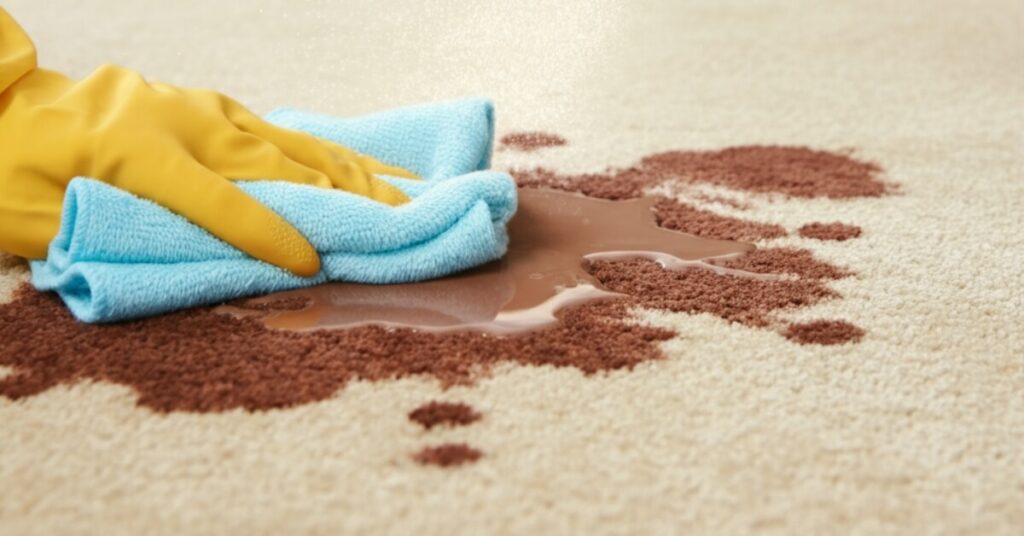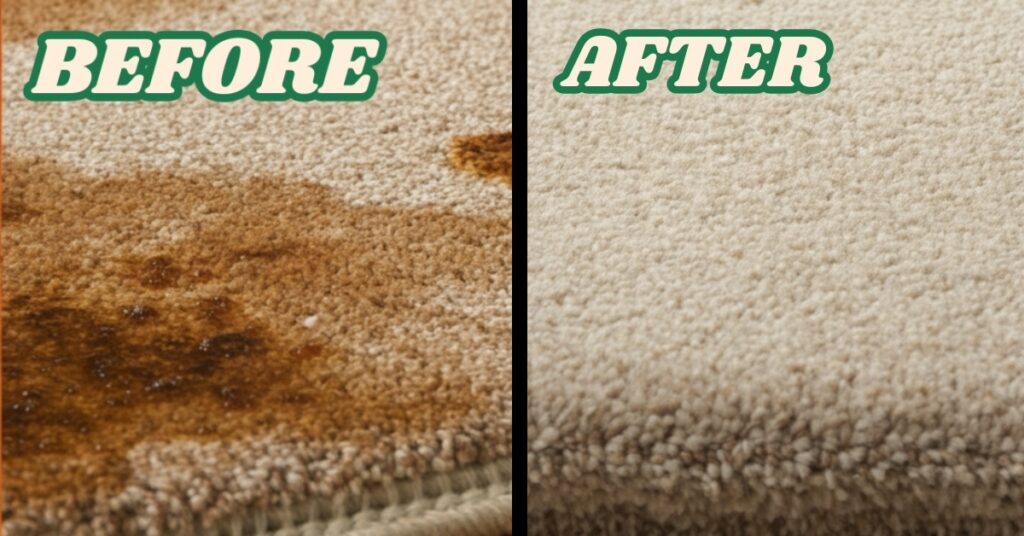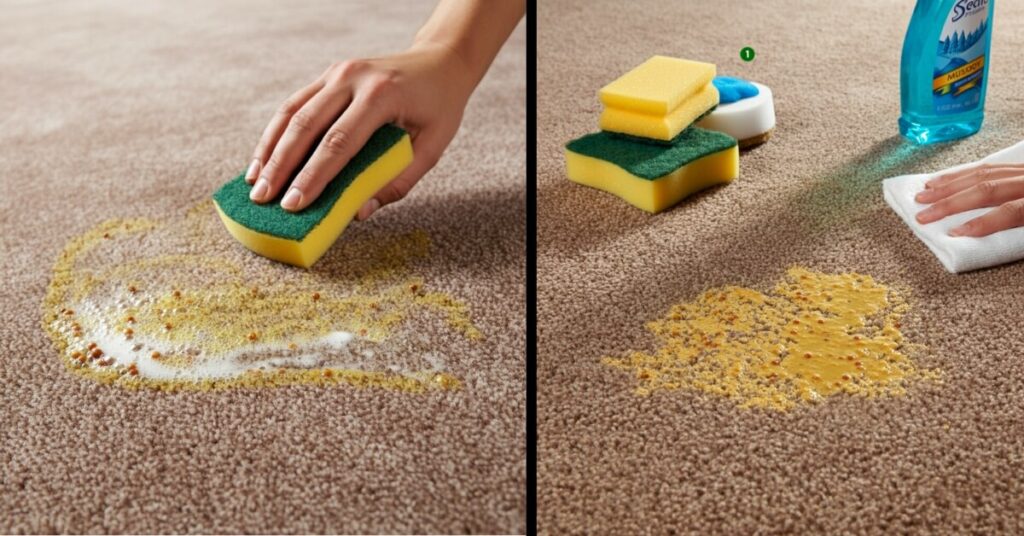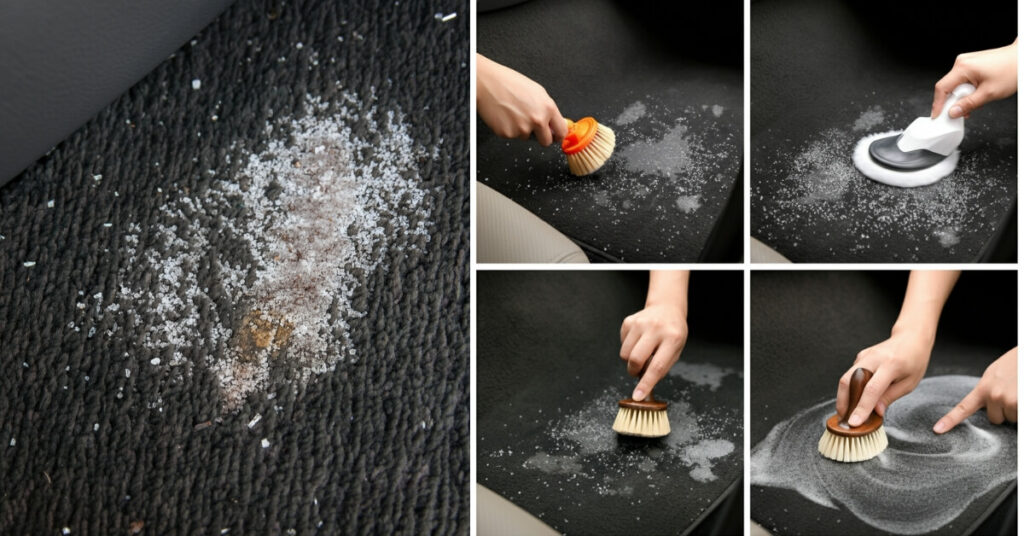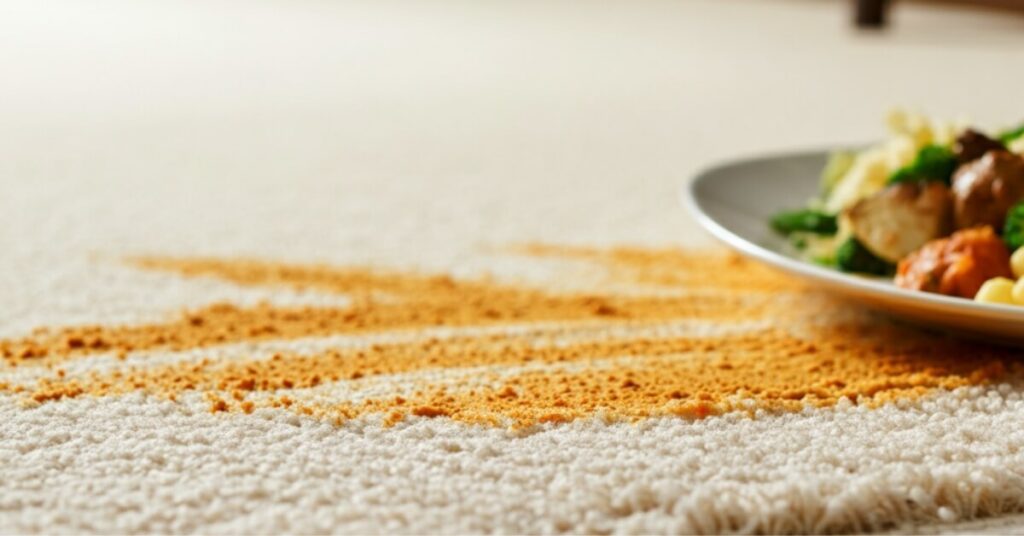As an Amazon Associate, I earn from qualifying purchases.
Spills are a common occurrence in busy homes, especially when young children and their friends are present, or when the whole family is having fun together. Chocolate milk, a favorite drink for many, can leave a nasty stain mark if it tips over on a soft carpet.
What makes this particular type of stain so hard to remove? This blend of sugary stickiness, dark cocoa pigments, and milk proteins creates the perfect storm that works against clean carpets. If left untreated, these elements bond tightly to carpet fibers, forming dark patches and bad odors that are difficult to endure. Most home cleaning solutions, such as regular vacuuming or carpet cleaning products, will not be effective.
Don’t stress! With the right knowledge, thoroughness, and proper carpet care products, you can effectively remove chocolate milk stains and restore your carpet to its original beauty. In this guide, we’ll provide practical details on how to remove chocolate milk stains from your carpet, recommend useful products, and offer tips to help prevent future spills.
Contents Overview
Why Chocolate Milk Stains Are Difficult to Remove
Before discussing removal techniques, it is essential to understand why chocolate milk stains can be particularly challenging. Chocolate milk is a carpet hazard because of its thick, sugary nature.
Milk Proteins
The two main proteins found in milk—casein and whey—make chocolate milk stains such a hassle to deal with. Once spilled, these proteins bond to carpet fibers and begin to dry. After some time, these proteins essentially trap the stain and any nearby grime, dust, or dirt, further amplifying the damage.
Sugar Content
Chocolate milk is filled with both natural and added sugars. With the right combination, you get that chocolate milk flavor that many people love. However, the sugars can act as an adhesive to dirt particles, pet hair, and other debris. If not fully cleaned, over time this spot will continue getting dirtier with every step due to the dirt and grime it attracts.
Dark Pigments From Cocoa
The appealing taste of chocolate milk is derived from its rich color, but it also serves as a powerful dye that can easily penetrate and stain light carpets. These dark pigments can seep in and create noticeable and tough-to-remove permanent marks that go beyond simple cleaning.
By blending all three elements, a spill creates the risk of both a stain and an odor. This chocolate milk remains tempting, but allowing the spill to set or cleaning only the top layer will leave some proteins or sugars and result in a decaying smell that worsens discolored spots. This is the reason why the correct method and speed is critical.
How to Remove Chocolate Milk Stains From Carpet (Step-by-Step)
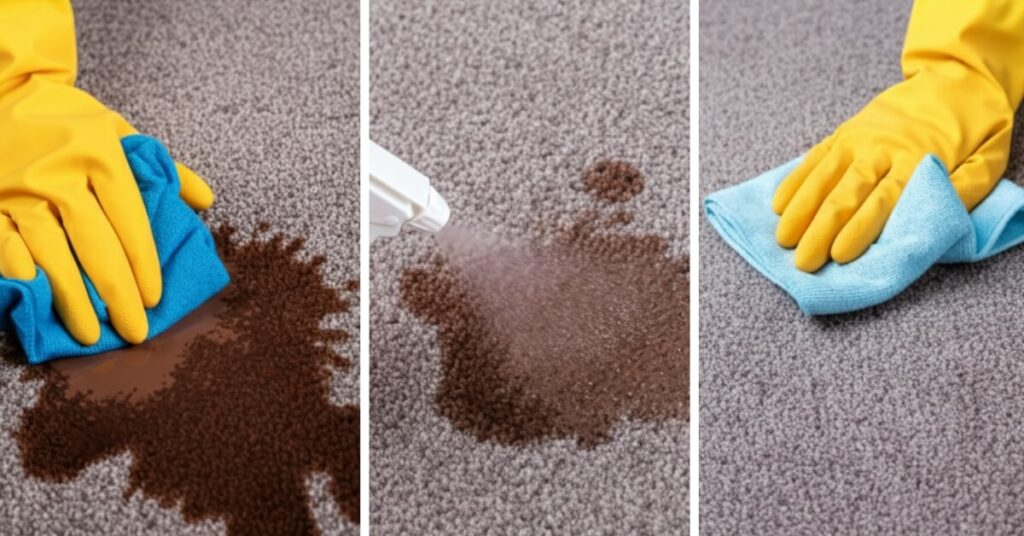
There is no reason to panic and rush to call an expert. Attempting to scrub the stain or using random cleaning products will do more harm than good. Following a systematic approach works best with elaborate stains like chocolate milk. Each step mentioned below focuses on a specific task, like removing liquid, breaking down sticky essences, lifting odor-causing proteins, and restoring the carpet to its desired look and feel.
Step 1: Blot The Area Immediately
The very first step is to soak up the spill using multiple layers of paper towels or a clean, white cloth. Blotting the area without applying any form of pressure is the best way to go about it. Applying pressure, rubbing, or scrubbing the stain only aggravates the situation by pushing chocolate and milk further into the fibers and expanding the mess.
Act fast, and you are likely to remove a large percentage of the problem immediately. Use a towel to blot the area and switch to a clean towel section as the one you’re using gets wet. Continue to blot until almost no moisture transfers to the towel. This treatment is essential to minimize the amount of milk permeating into the underlying carpet padding, as this will help avoid lingering smells.
Step 2: Prepare a Mild Cleaning Solution
In this step, you want to start removing the cocoa by breaking down sugars. Take two cups of warm water and mix it with a teaspoon of colorless dish soap. Avoid soaps containing strong dyes or bleach. Stir the mixture until all the soap dissolves. Warm water serves two purposes. It dissolves the mixture easily, and it loosens sticky proteins from the carpet’s fiber.
You can put the solution in a spray bottle for simpler application; just be cautious not to drench the carpet. Too much liquid can cause the padding to become soaked, leading to mildew and lingering odors. Overusing harsh cleaners or laundry detergents will damage the carpet fibers by causing rigid, soapy buildup.
Step 3: Apply Solution and Blot Gently
Get a clean, soft cloth or sponge and dip it in the soapy water. Blot, dab, or pat the area moving from the outer edge to the center. This prevents the spreading of the stain. You will notice some chocolate color coming out onto the cloth. Keep repeating this process until no more color is removed.
Do not use a scrub or blot with a colored rag, as this can cause the carpet fibers to bleach or lose their texture. The key to success here is being patient and steady. Repeat as many times as necessary, but ensure that you remove excess liquid solution to prevent oversaturating the area.
Step 4: Use Vinegar Solution for Remaining Stains
If you see any brown marks left behind or shiny spots on the surface, the area is sticky, then it is time for vinegar. Vinegar works wonders as a stain remover. To prepare this solution, take one part of white vinegar (do not use apple cider or colored vinegar as it can leave marks) and mix it with two parts of warm water. Pour the mixture into a spray bottle for easy application and lightly mist the stained area.
Vinegar will break down any leftover sugars and proteins and neutralize any lingering odors from milk. Blot using a damp, clean cloth while rotating to a new section of cloth as needed. While vinegar’s smell can be unpleasant, it does dissolve the toughest compounds and carpet odors, and any odors will dissipate as the carpet dries.
Step 5: Rinse and Dry
When the area is dry, use clean water to rinse off the area. Stains, soap, and vinegar residue might make your carpet feel crunchy and attract dirt if not removed. Use a dry towel to scrub or dab the area, drawing out as much moisture as possible.
Allow the carpet to fully air dry before walking on it to avoid soiling the damp carpet. You can speed up drying time by positioning a fan or window close to the carpet or using a hair dryer on cool settings. You can check out our article how to dry carpet after cleaning to have a proper drying guideline.
Step 6 (Optional): Remove Leftover Smells with Baking Soda
If residual scents are an issue—and they often are with milk spills—sprinkle a generous amount of baking soda over the area. To get the best results, leave it for a few hours or even overnight. For best results, let it sit for at least 30 minutes.
Baking soda is great for absorbing both moisture and scents. Once the time is up, vacuum the area thoroughly to remove all traces. The carpet will look and smell like new.
DIY Solutions to Remove Chocolate Milk Stain from Carpet
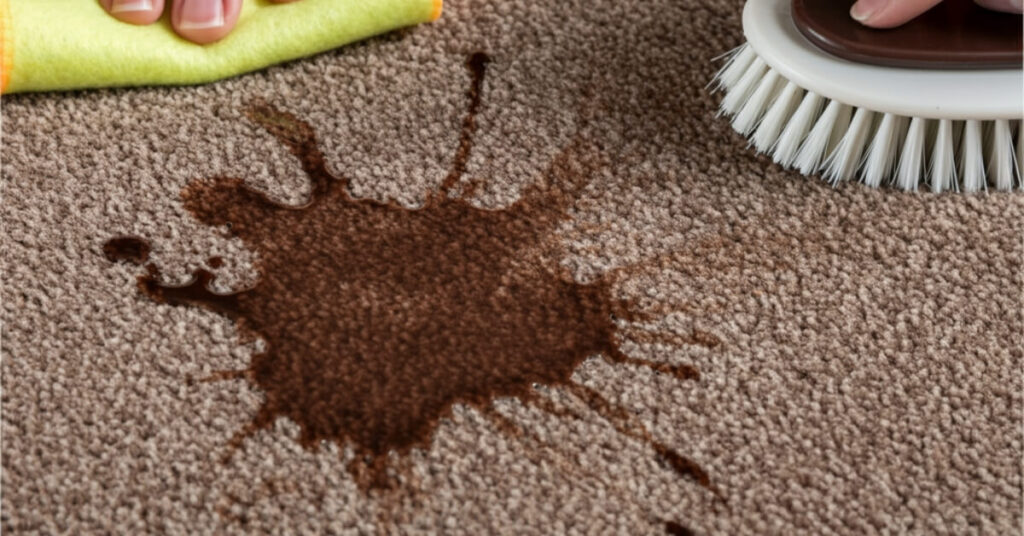
Dish Soap Solution
Works great to remove oily and cocoa stains. Remember to use a small amount, as oversaturation can slow drying time.
Vinegar and Water Spray
White vinegar mixed with water effectively breaks down sticky residues and mild odors without fading colors. There’s no need to purchase pricey add-ins.
Hydrogen Peroxide Mixture (Use With Caution)
On pale or white carpets, a diluted hydrogen peroxide solution (one tablespoon of peroxide in three parts water) can help lighten stubborn spills. However, you want to be cautious because some fibers may be bleached with peroxide. Always do a test spot first.
Avoid Using Bleach Carpet Cleaners
Some homeowners try using bleach-based carpet cleaners, hoping to get rid of tough stains. While bleach may seem like a strong solution, it can permanently damage or discolor your carpet, particularly darker or natural wool fibers. These are always better left to gentler stain removers.
Pro Tip:
Store a small cleaning caddy with vinegar spray, dish soap, and fresh microfiber cloths under your kitchen sink or in the laundry room. Being able to grab the caddy without running around looking keeps you more likely to tidy up chocolate milk stains right away. This gives you the best chance to remove chocolate milk stains before they dry and set fully.
How to Stop Beverage Stains from Ruining Your Carpet
Knowing how to clean is just a bonus when you can simply avoid stains altogether, worrying less about tedious chores. Here is how you can prevent carpets from getting stained with beverages:
- Create a Snack Zone: Designate the kitchen, dining nook, or breakfast bar as a designated snack and drink area. The non-carpeted zones will make it easy for kids and family members to enjoy their favorite spills without getting them.
- Clean-Up Routine: Establish a family snack time where everyone cleans up together. Teaching children to report spills and help clean them up is a valuable skill that can be learned from an early age and prevents stains from becoming permanent.
- Protective Rugs or Mats: Place easy-to-wash mats or rugs that can be quickly tossed in the washing machine in high-risk places like under sofas, coffee tables, or anywhere children play on the floor.
FAQs
Will chocolate milk stain come out completely?
Most chocolate milk stains can be treated effectively with the right cleaning process and masking steps. Immediate action always makes things easier, and while older stains may be tougher, they can often still be dealt with using the method here.
Can I use hydrogen peroxide on chocolate milk stains?
Yes, but only pertaining to light colored carpets, as well as testing a hidden area first to gauge results. Dark or patterned carpets can get damaged with hydrogen peroxide. Use the worst-case scenario. Followed with a water rinse too.
What if the stain is old and dried?
Older and dried chocolate milk stains are likely to receive multiple treatments. These older stains begin by moistening the area using warm water and loosening the hardened crust. Followed by the previous steps, and finishing with an enzyme cleaner for odor and protein removal.
Does milk cause a bad smell in the carpet over time?
Yes, if milk sits deep within the carpet fibers, the bacteria responsible for mildew build and produce a sour odor. Even if a visible sign no longer exists, it entails using deep rinsing followed by baking soda to neutralize any potential hidden smells.
Conclusion
Chocolate milk stains are a common occurrence in nearly every household with children, and some carpets will inevitably have these stains. However, with the right cleaning procedures, they don’t have to be permanent. A combination of enzyme cleaners and odor removers can help you win the battle against carpet damage. Prevention is also very easy using smart family methods and spill-proof cups. With these, you can preserve the carpets for years.
When it comes to an old or persistent stain, keep in mind that professional carpet cleaners have specialized equipment and solutions for deep cleaning and odor removal. Consider scheduling a professional visit to protect the investment you’ve made in your home’s comfort and appearance.
For most households, knowing how to remove a chocolate milk stain from the carpet and acting promptly will help keep up a spotless and inviting home, no matter what life spills.
As an Amazon Associate, I earn from qualifying purchases.
